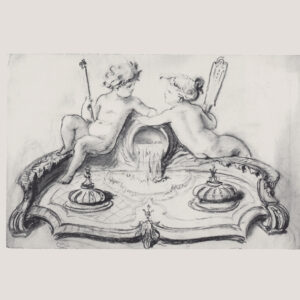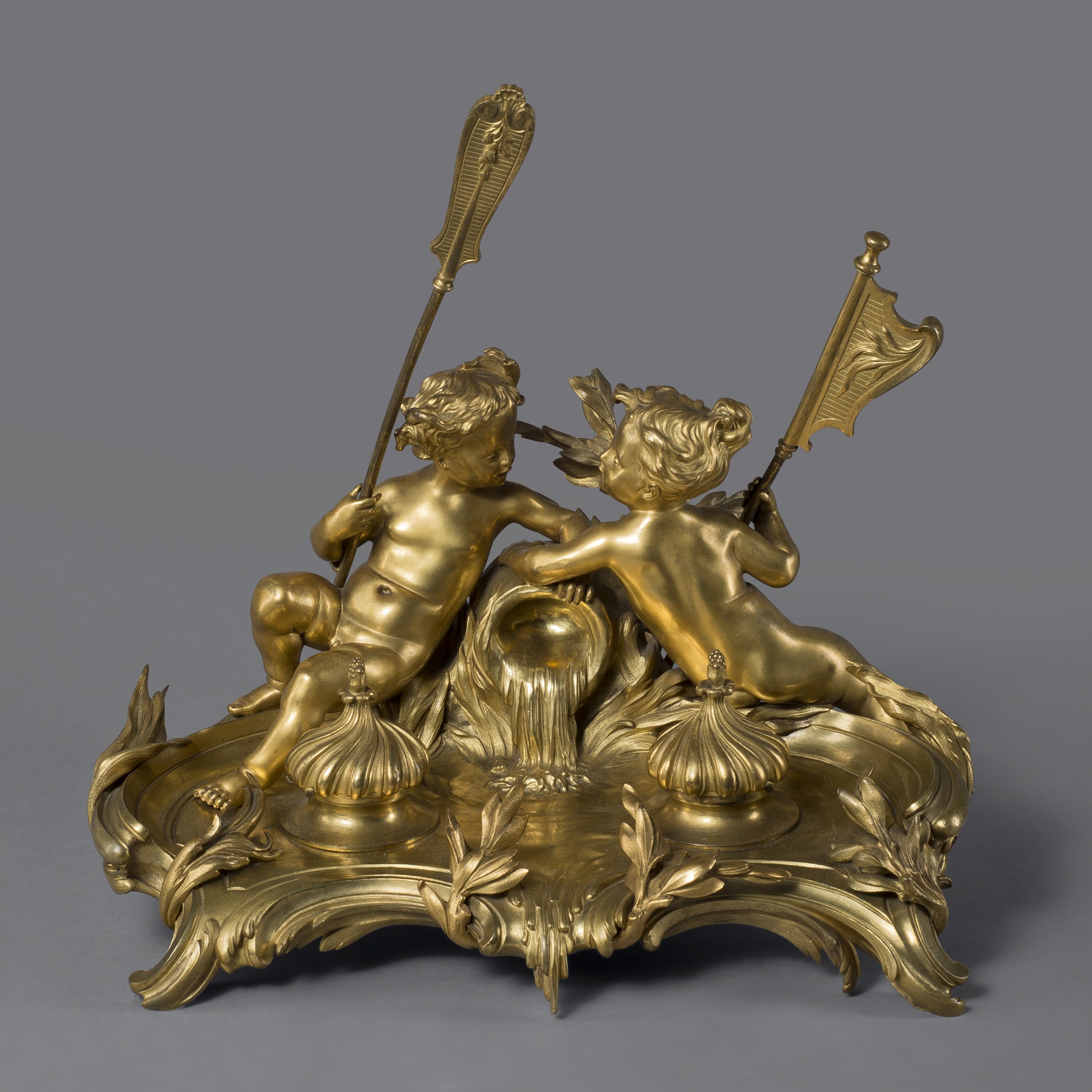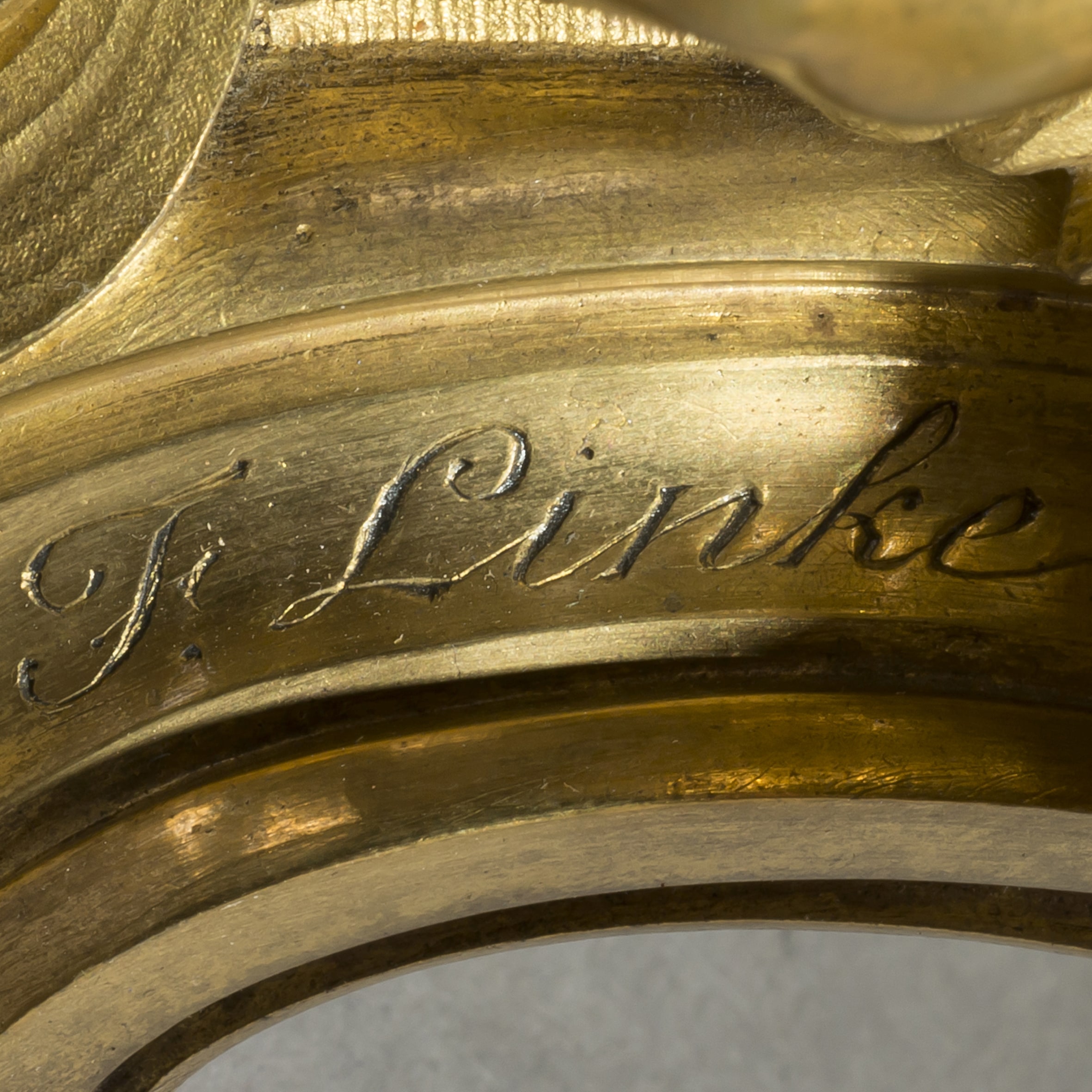Франсуа Линке
Позолоченная бронза Encrier работы Франсуа Линке и Леона Мессаже
£38,000
A Gilt-Bronze Encrier By François Linke and Léon Messagé. Index number 709. Signed to the edge 'F. Linke'. This exceptional and ambitious encrier...
Размеры
Height: 36 cm (15 in)Ширина: 35 см (14 дюймов)
Глубина: 23 см (10 дюймов)
Описание
A Gilt-Bronze Encrier By François Linke and Léon Messagé.
Index number 709.
Signed to the edge ‘F. Linke’.
This exceptional and ambitious encrier is modelled as two putti, each holding a standard and sitting on the water’s edge, the two inkwells with hinged spirally-fluted covers with glass liners.

Charcoal drawing by François Linke or Léon Messagé (Courtesy Christopher Payne/Linke Archive)
This important inkwell is based on Léon Messagé’s celebrated sculptural group ‘La Source’ and was originally intended by Linke to form part of his spectacular stand at the 1900 Paris Exposition Universelle. Like seven or eight other pieces originally intended for inclusion on the stand, it would seem the encrier was a casualty of both Linke’s over-ambitious production schedule and the financial burden that the manufacture of such ornate and high quality work imposed. It was eventually shown on the stand in September after the gilding was finished by Picard at a cost of 90 French francs. The costs of the model were very high: some 2024 francs (of which Message’s combined fee was 1158 francs 40 centimes), underlining the originality and complexity. The 1900 Exposition example was sold, along with three important pieces of furniture from the stand (the Grand bureau and associated armchair, and the Bahut Louis XV Mars et Vénus), to the South African banker and diamond merchant Solomon Joel. A further six encriers were produced up until 1925.
Франция, около 1900 года.

The ‘encrier exposition’ visible on Linke’s stand at the 1905 Liège Exposition universelle (Courtesy Christopher Payne/Linke Archive)
Léon Messagé
Léon Messagé (1842-1901) had a brilliant, but short lived career. He is best known for his incredible sculptural collaboration with François Linke for the 1900 Paris Exposition Universelle. A gifted sculptor, Messagé was also responsible for much of the design and creative work for Roux et Brunet and Joseph-Emmanuel Zwiener.
Messagé enjoyed great success as a designer/sculptor before his collaboration with Linke. Indeed he was mentioned as a gold medal winner at the 1889 International Exhibition and was especially praised for his work on a cabinet by Zwiener. He came into contact with Linke in 1885 and it appears from then on Linke employed him on a regular basis.
Messagé was primarily influenced by rococo ornament but he strove to re-interpret it. He did not produce slavish copies, and his original approach can be appreciated in Linke’s celebrated Grande Bibliothèque and Grand Bureau exhibited at the 1900 Paris Exposition Universelle. A number of drawings by Messagé are recorded and after his success at the exhibition of 1889 he was encouraged to publish his designs.
‘Cahier de dessins & croquis, style Louis XV: bronzes, orfèvrerie, décoration, meubles’ was first published by the sculptor himself, from his Paris address of 40 rue Sedaine. There were five sections with an elaborate title page surmounted by the sculptor’s cipher or talisman of a wing, a pun on his own name as the messenger to the Gods, a motif he used many times on the handles of furniture designed for Linke.
As a sculptor Messagé was trained to produce a wax maquette or model prior to working on a piece. It is especially interesting that his maquettes were of the piece of furniture in its entirety, a rare and exacting task occasionally seen for eighteenth century French Royal commissions. For Messagé it was not just a matter of producing decorative mounts; the piece was conceived as sculpture, bronze, timber and marquetry as one.
Bibliography:
Payne, Christopher. François Linke, 1855 – 1946, The Belle Époque of French Furniture, Antique Collectors’ Club, (Woodbridge, UK), 2003; pp. 71-95.
Mestdagh, Camille & Lécoules, Pierre. L’Ameublement d’art français: 1850-1900, Les Editions de l’Amateur, (Paris), 2010; pp. 173-176.
Дата
Около 1900 года
Происхождение
Франция
Средний
Позолоченная бронза
Подпись
Signed to the edge 'F. Linke'.
Франсуа Линке (1855 - 1946) был самым значительным парижским краснодеревщиком конца XIX - начала XX века и, возможно, самым востребованным краснодеревщиком своего периода.
Он родился в 1855 году в маленькой деревне Панкрац на территории нынешней Чешской Республики. Согласно записям, Линке проходил стажировку у мастера-краснодеревщика Ноймана, затем в 1875 году в возрасте 20 лет он приехал в Париж, где жил до самой смерти в 1946 году.
Известно, что зарождающиеся мастерские Линке активно работали в Париже на Фобур Сент-Антуан уже в 1881 году, и в это время он поставлял мебель для других более известных производителей, таких как Янсен и Кригер.
Качество мастерства Линке было непревзойденным среди его современников и достигло своего пика на его впечатляющем стенде на Всемирной выставке в Париже в 1900 году, где его Гранд Бюро получило золотую медаль. Он поставил на кон свое состояние и репутацию, представив на выставке несколько захватывающих дух предметов мебели со скульптурными креплениями самого исключительного качества и пропорций. Его авантюра сработала, и репутация была настолько прочной, что Linke оставался ведущим мебельным домом в Париже вплоть до Второй мировой войны.
Как писал журнал "Арт Джорнал" в 1900 году о стенде Линке:
"Работа М. Линке ... была примером того, что можно сделать, если искать вдохновение среди классических образцов Людовика XV и XVI, не копируя в каком-либо смысле эти великие произведения. Работа М. Линке была оригинальной в истинном смысле этого слова, и как таковая, она понравилась умному искателю действительно художественных вещей выставки. Замечательный талант был использован при изготовлении великолепных предметов мебели, представленных на выставке....'.
Формирование характерного стиля Линке стало возможным благодаря его сотрудничеству со скульптором Леоном Мессаже. Вместе Линке и Мессаже разработали мебель для выставочного стенда Линке в 1900 году, украшенную аллегорическими фигурами, отлитыми в высоком рельефе, что стало примером способности Линке органично объединять различные средства резьбы по дереву, бронзы и маркетри в динамичное единое целое.
Сегодня Линке наиболее известен благодаря исключительно высокому качеству своих работ, а также своему индивидуализму и изобретательности. Все его работы имеют самые тонкие, самые пышные крепления, очень часто применяемые к сравнительно простым тушам. Технический блеск его работ и художественные изменения, которые они представляли, никогда не будут повторены.
Библиография:
Пейн, Кристофер. Франсуа Линке, (1855 - 1946), Belle Époque французской мебели, Клуб коллекционеров антиквариата, (Вудбридж, Великобритания), 2003.
Мейер, Джонатан. Великие выставки - Лондон, Нью-Йорк, Париж, Филадельфия, 1851-1900, Клуб коллекционеров антиквариата, (Вудбридж, Великобритания), 2006; стр. 298 - 300.
Ledoux - Lebard, Denise. Les Ébénistes du XIXe siècle, Les Editions de l'Amateur, (Paris), 1984; pp. 439-43.
Revue Artistique & Industrielle, (Париж), июль-август 1900 года.
Корал Томсен, Д. (ред.), Парижская выставка 1900 года, Художественный журнал, 1901; стр. 341.
Payne, Christopher. François Linke, 1855-1946, The Belle Epoque of French Furniture, p. 90, pl. 97; p. 149, pl. 157; p. 150; pp. 182-183, pls 197 & 198 as exhibited at the Liege exhibition in 1905 & p. 480 for the original notes in Linke’s Blue daybook of the late 1890s.
ВАМ ТАКЖЕ МОЖЕТ ПОНРАВИТЬСЯ
-
£65,000 Добавить в корзину

В честь Клода Мишеля Клодиона
A Large and Rare Gilt and Patinated Bronze Jardiniere or Monumental Wine Cooler
-
£7,500 Добавить в корзину

Christofle et Cie.
Пара стеклянных графинов с серебряным покрытием и гравировкой в стиле "японез
-
£4,700 Добавить в корзину

Севр (стиль)
Фарфоровая шкатулка для драгоценностей с монтировкой в стиле Севра эпохи Людовика XVI














 Печать
Печать